The Moto G (2015) Review
by Brandon Chester on August 19, 2015 8:00 AM EST- Posted in
- Smartphones
- Mobile
GPU Performance
While CPU performance has improved significantly in low-end and mid-range smartphones, the same can't be said of GPU performance. Adreno 306 is really just a variant of Adreno 305, which we have covered time and time again in reviews of Snapdragon 400 devices. I already discussed in my Moto E review that I'm not happy with the graphics performance in Snapdragon 410 and with the GPU configuration in the Moto G being exactly the same there won't be any significant changes to graphics performance.
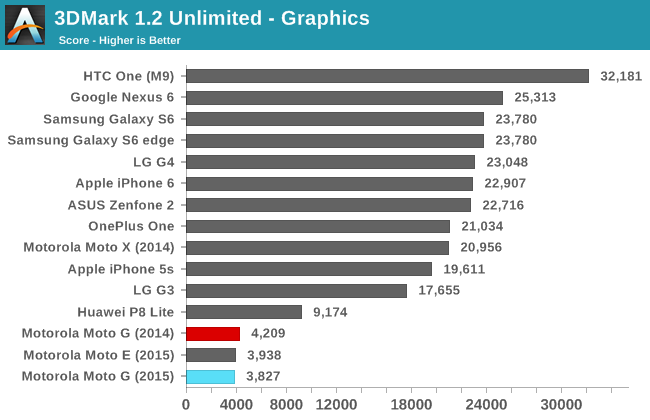
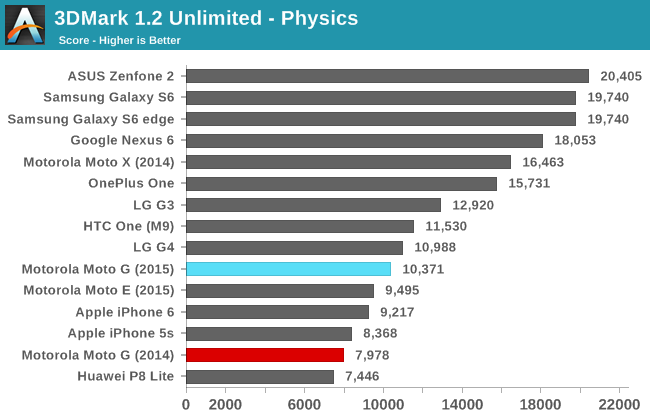
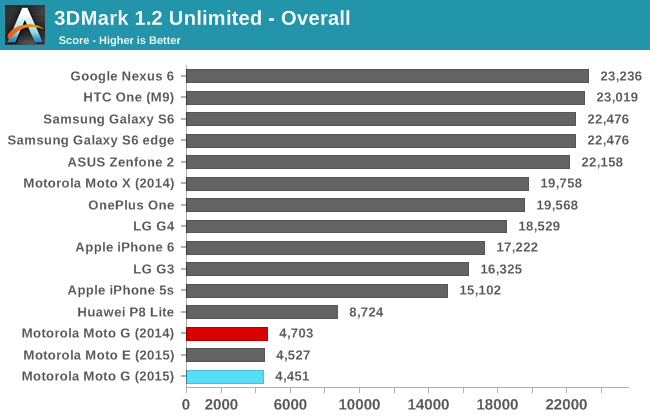
Due to the way 3DMark calculates its overall score, it's not possible for a device to pull ahead based on the score of one test being substantially higher than the other. Because of this, the Moto G's improvement in the physics test doesn't lead to it coming on top overall due to its slightly lower graphics score. I would just attribute the lower graphics test score to testing variance, and so in reality the Moto G will be slightly faster than the Moto E or older Moto G in any physics heavy games.
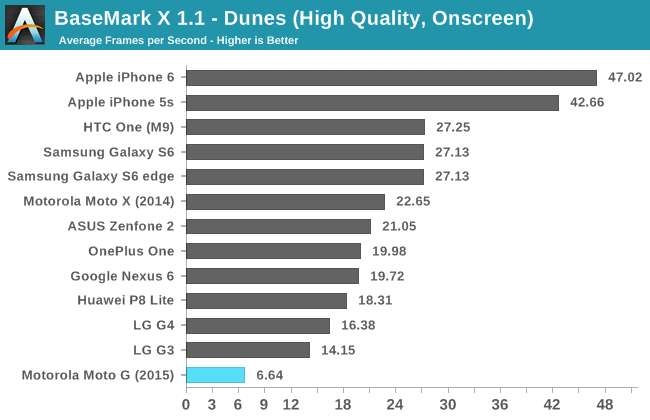
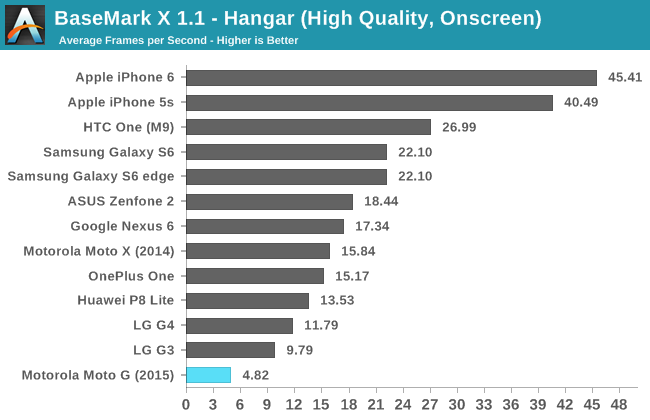
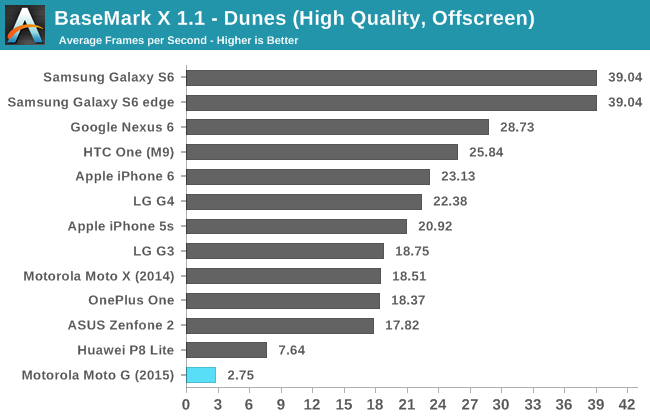
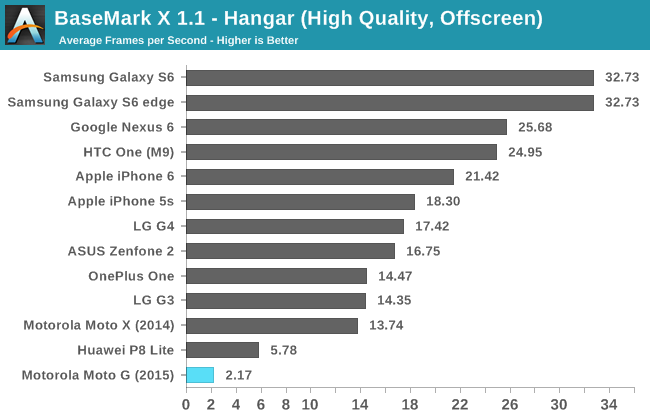

Driver bugs had previously prevented me from running BaseMark X on Snapdragon 410 devices. This appears to have been resolved, as the test runs and completes on the Moto G. There's not much to be said about the scores, which are at the bottom of the charts in every single test.
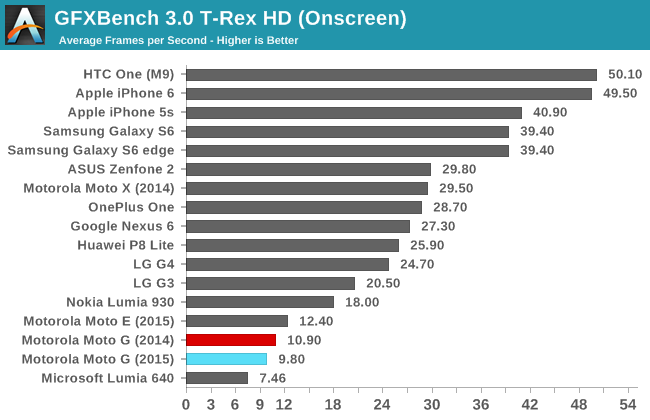
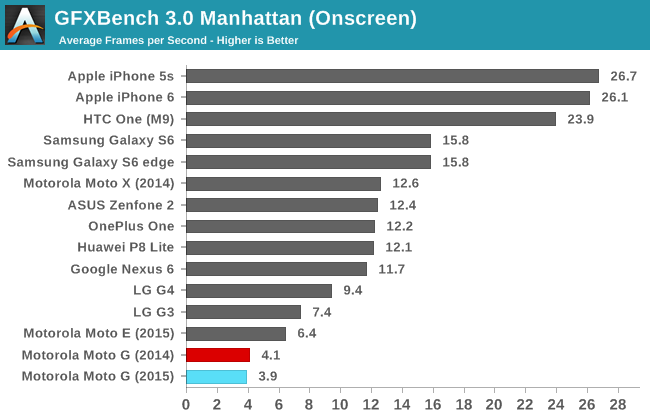
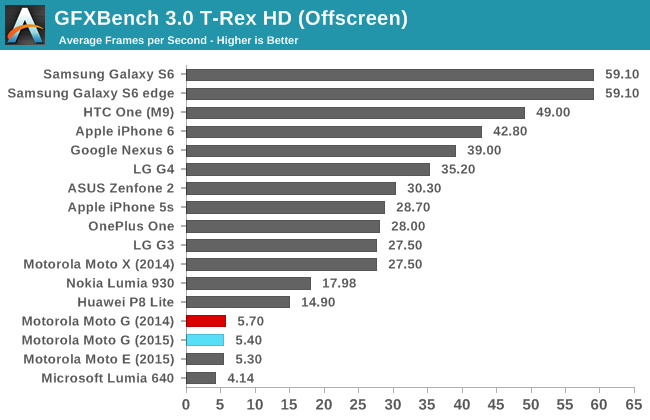
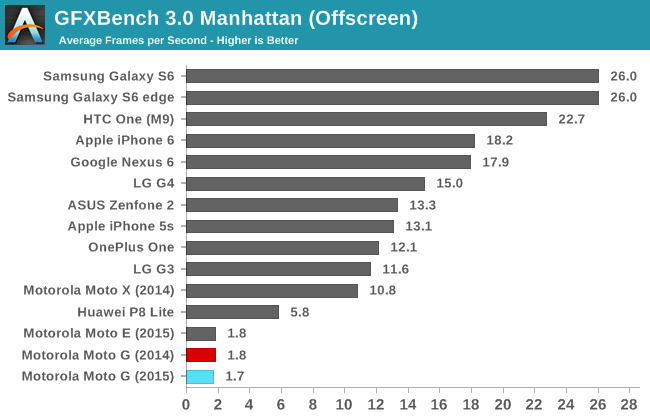
As expected, performance in GFXBench on the new Moto G is essentially identical to that of other Adreno 305/306 devices. Unfortunately they all share a space at the very bottom of each chart, and end up being between 1/3 and 1/2 the speed of the Adreno 405 GPU in Snapdragon 615.
When I reviewed the Moto E I gave the GPU performance a pass because the phone sold for $100-130. With the Moto G priced as high as $219 for the high end model, I have to say that $30 more gets you the Huawei P8 Lite which uses Snapdragon 615 and Adreno 405 which is substantially faster. There's not much Motorola could do about this apart from using a completely different SoC, but obviously that wasn't a possibility when building a device that does start at $179 even if it scales up to $219. I just hope that we see some improvement in GPU performance on devices at this price point in the near future.
NAND Performance
Flash memory performance can often be an invisible performance bottleneck when applications are running in the background, writing files, or performing updates. Low-end and mid-range devices often suffer from very poor NAND performance which can cause stuttering or slowness whenever there's heavy I/O activity occurring.
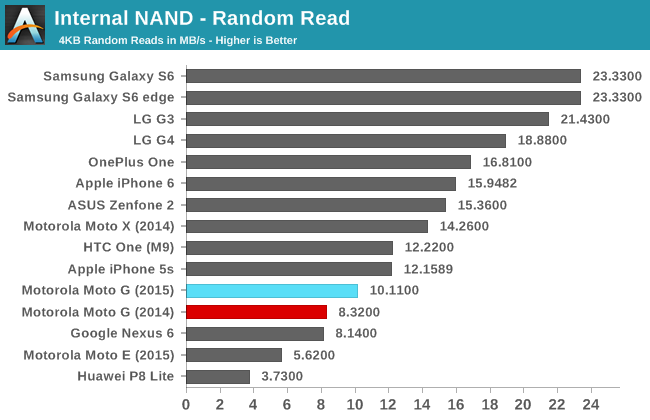

Random read speeds on the Moto G are much faster than the Moto E or the Huawei P8 Lite. They're certainly not the fastest on record, but they're at the point where I wouldn't worry about them causing performance problems in most circumstances. The random write speed is a very curious case, with it being faster than every other device on record. There doesn't appear to be any problem with the testing, and it seems that the Moto G's NAND simply has relatively fast random write speeds.
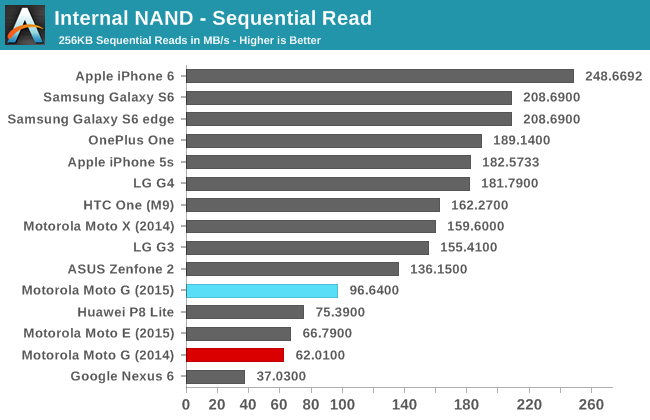
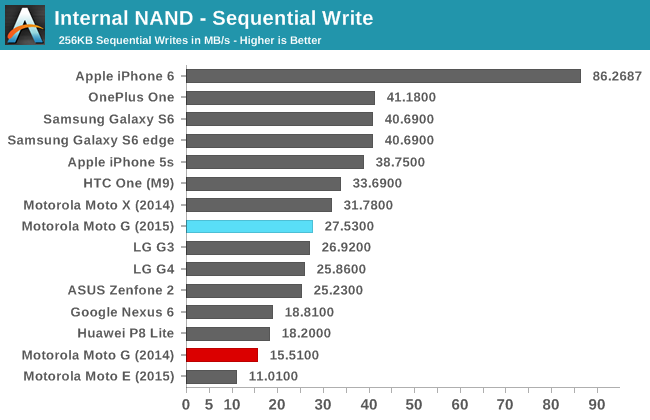
Sequential read speeds on the Moto G are faster than other mid range phones, but not as fast as the Zenfone 2 or flagship Android devices. Sequential writes sit right in the middle of the chart and are around the same speed as the NAND in LG's flagship devices. Whether it's random or sequential access I don't expect users will encounter any performance issues on the Moto G caused by poor NAND performance.










90 Comments
View All Comments
3DoubleD - Wednesday, August 19, 2015 - link
Thanks for the response!1. The 5W charging time would be great! Thanks for adding that.
2. I agree, it is too bad they are hamstringing the GPUs in these devices. Three generations of Moto G including the same GPU is pretty disappointing. It seems Motorola is keeping customers interested in AAA gaming on their more expensive phones, which is understandable. From what you are saying, it sounds like the poor display calibration and poor visibility in sunlight would be more apparent to non-gamers than the GPU.
3. What I'm referring to is your comments in the concluding remarks: "The waterproofing is definitely a neat addition, but I think in most cases it's just a nice thing to have rather than a selling point. Once waterproofing is accompanied by the ability to use the display when it's really wet I'll be a lot more interested in it." I suspect many people will see waterproofing as a selling point (AKA a desirable feature) just from a pure ruggedness standpoint. Instances where people are deciding between several mid-range Android phones and pick the Moto G based on it being waterproof are probably more likely than decisions based on many of the other specs.
4. My problem with device thinness is that the benefit of thinner and thinner devices is dubious, yet the benefit for keeping the same thickness, or even increasing it, is substantial. I don't think a objective argument can be made for why a 6.9 mm phone is better than a 8 mm phone or even an 11.6 mm phone (like the Moto G). Even the subjective 'design' argument is pretty shaky, considering everyone was swooning over smartphone designs that first made it to 10 or 11 mm.
So as leading reviewer of phones and a spokesperson for the masses, I'd challenge you to develop a metric for phone thickness that equally considers 'thin design' with ease of use and battery life. IMO manufacturers hit the thin-enough-to-be-usable limit years ago. Let's stop praising thinness-at-all-costs in reviews (as is typical in a flagship Android or iPhone review) and start making a big deal when the design needlessly sacrifices battery life for thinness.
djc208 - Wednesday, August 19, 2015 - link
Seems to me the one major category that is missed between those two phones is support. More and more I'm just as interested in how it will be supported, and I wonder how well the Zenphone will be supported against future OS updates. I'd tend to lean toward Motorola for long term support. LG brought be in with great hardware but turned me off with crappy software support.Moto1 - Wednesday, August 19, 2015 - link
Zero support from Motorola. Emailed and called and all I get is generic replys-not related to my question. I bought the first moto g in anticipation of fast updates and have had zero-which sucks cause I was promised 5.0 over a year ago.Machete - Thursday, August 20, 2015 - link
False, we have a 1g Moto G in family and it was updated to 5.0 months ago.tipoo - Sunday, August 23, 2015 - link
Must be your carriers fault. My first gen G has been rocking 5 for months.tipoo - Wednesday, August 19, 2015 - link
MicroSD and 2GB RAM were the two things I sorely missed in my first gen G, so this looks like a fair upgrade. Honestly, it's all the phone most people need. Even the weak GPU runs most modern Android games well. The RAM was always the bigger issue than the processing speed, and the minor bump to the latter will be a nice bonus.Now just bring Moto Maker for the G to Canada and take my money, Motorola!
YukaKun - Wednesday, August 19, 2015 - link
So... Is this better than my SGS2? Y know the CPU is better, but is the camera and GPU?I'm having a considerable loss in battery life as of late (from 3 days to just 2) and the S2 is still running anything I need it to (GMail, GMaps and other "light" stuff) with no hiccups. So in my mind, instead of getting a battery replacement, maybe jumping to the MotoG 2015 might be a good idea.
Cheers!
a1exh - Wednesday, August 19, 2015 - link
Battery replacements are soooo cheap for the SGS2 though. If it is still going and you're happy. The SGS2 camera was better than the MotoG 2013a1exh - Wednesday, August 19, 2015 - link
As a MotoG 2013 customer I wanted the 2015 to be great. But it isn't. So the Vodafone Smart Ultra 6 is looking like the PAYG phone to get in the UK only it is a bit bigmkozakewich - Wednesday, August 19, 2015 - link
Devices like this really highlight the need for colour correction on Android. If it can fill the full sRGB gamut, the only thing left is to tell it where to put the colours. There's no reason something like this shouldn't be able to pull a dE2000 of 1.I remember the review of the Stream 7. Since it ran Windows, they were able to run a correction suite on it, and it ended up with a really good score despite its inability to saturate the blues.